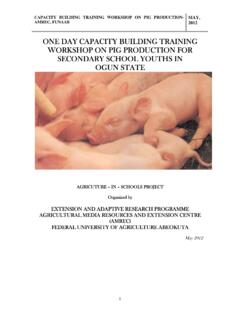Transcription of Food and Feeding Habits in Fish
1 FIS 307: FISH ECOLOGY (2 UNITS). Food and Feeding Habits in Fish There are four basic eating groups among fish: carnivores, herbivores, omnivores and limnivores. Each group of fish needs to be fed in a particular way. Carnivores are meat-eating fish. Whilst they will never damage your plant life, you will be lucky if you do not find any of the smaller fish disappearing mysteriously. If there are smaller fish in the aquarium with a carnivore, sooner or later the smaller fish will end up in the carnivore's stomach. Carnivores need at least 45% of protein in their food, without which they become severely malnourished.
2 Although many of the prepared foods are spiked with extra protein to help such fish, carnivores are happiest when they are fed live food like worms. An added benefit is that chasing their prey seems to whet their appetite even further. Recommended food for the carnivores would be: - Earthworms, Red worms, Tubifex worms and Daphnia. - Larvae of mosquitoes or fruit flies. - Oysters, shrimps, clams and other fish. If these are kept frozen, they need to be thawed and then sliced into slivers. - Lean chicken, turkey and salmon.
3 These should be cooked, but never fried. - Supplements in the form of flakes or granules and pellets for added nutrition. Herbivorous fish are those that will eat only plants. These fish need to graze very often, and whether they are fed regularly or not, they will nip at your plant life. Many aquarists who like herbivores keep plastic plants in their aquarium. If real plants are used, the aquarium runs a risk of having a badly mauled garden. It is a good idea to feed these fish with fresh veggies. Planting leafy vegetables like spinach into the substrate is a good trick.
4 The fish will keep nipping at these. Care should be taken to remove the frayed plants before they start decaying and rotting in the water. Recommended foods for this variety are: - Cucumber, peas and potatoes. These can be kept frozen and be chopped into tiny pieces at mealtime. - Vegetable flakes come in a variety of flavors. - Algal flakes will also be a favorite among this kind of fish. Omnivore fish will eat pretty much anything, and that makes them dangerous to plants as well as to other smaller creatures in your aquarium.
5 They are also voracious eaters and aquarists can sometimes mistake their eating frenzy for hunger. It is a common tendency to overfeed these species, and they do tend to pile on the fat very quickly if overfed. Limnivores are also known as mud-eaters. Limnivore fish feed mainly on algae and on the microorganisms in your aquarium. These kinds of fish are constantly eating, and can be given pellets and algae based foods. Proper Feeding practices are a matter of habit. They require some amount of patience, observation and consideration.
6 Understanding your fish and appreciating the differences between the different species help a lot when you feed them. The type of food, the culture conditions and the individual fish will all affect the quantity of food you should provide. In nature, there may be times when an adult fish starves for a day or two, or even for longer periods of time. The younger fish need more frequent feedings than the older ones. The fry have their own Feeding needs. Most Feeding problems arise due to overfeeding. More food also means more waste.
7 The excess food will putrefy and degrade the water quality. Under gravel filters can get clogged with uneaten food wastes. Frequent water changes along with cleaning of decorations, rearranging of plants etc will help to control the debris collection in the aquarium. Loaches, catfish and other common bottom- Feeding fish will help keep the aquarium clean. Deficiencies in vitamins can cause stunted growth, loss of appetite, cloudy eyes, weakness or tumors in fish. For this reason it is advisable to give your fish vitamin supplements from time to time.
8 No supplement should be left too long in your water. Adding any unnatural substance into your aquarium should be followed up by a water change in a day or two. This will keep the fish as well as the beneficial bacterial colony thriving. NICHE CONCEPT. Every organism has a place to live in nature, a functional role in that place, and a complex set of adaptations for reproducing its kind. On the surface, this observation might seem to be obvious, even trivial. However, in order to understand our biological world the biosphere, how it operates and ultimately how to protect it we need to understand at a deep level how organisms interact with each other and with their physical environment.
9 In this chapter we will examine further some of the concepts that ecologists use to organize their thoughts about the ways in which organisms use their environment, relate to each other, and assemble into communities or ecosystems. The most fundamental and perhaps most difficult of these concepts is that of the ecological niche. A niche refers to the way in which an organism fits into an ecological community or ecosystem. Through the process of natural selection, a niche is the evolutionary result of a species' morphological (morphology refers to an organism's physical structure), physiological, and behavioral adaptations to its surroundings.
10 A habitat is the actual location in the environment where an organism lives and consists of all the physical and biological resources available to a species. The collection of all the habitat areas of a species constitutes its geographic range. We will examine each of these concepts in turn using a historical approach where appropriate and discuss how these ideas can help us to understand the issues of modern conservation biology. GEOGRAPHICAL RANGES. One of the first things that people noticed as they started to study and write about the world was that when they visited different parts of the earth they found different species.











